A Sight Seeing (Reading) Tour!
Sight reading was definitely the weakest link for me as a young musician. With the main focus of lesson and practice time being learning new repertoire and improving technique, developing sight reading skills was largely neglected. I recall in my Grade 8 exam I lost almost as many marks on the sight-reading tests than the four prepared repertoire pieces combined!
You Have It or You Don’t?
By the time I was at university studying music, I was well aware of my deficiencies having encountered many musicians who were incredible sight readers. One of them was a professor who could literally play just about anything put in front of him at sight. I asked him how one goes about developing this ability and his answer was, “You either have it or you don’t!”.
Less defeatist was another lecturer who said it just takes lots of practice and also advised doing some accompanying. The latter is an excellent way to improve, but requires a certain base level of ability in order to avoid making a fool of oneself. I simply wasn’t good enough to make this a viable path to improvement and to be fair, many other instrumentalists were blissfully unaware of how difficult the piano parts for their repertoire often were!
Realising that this was holding me back, I did try incorporate sight reading into my daily practice for a few months. However, without a systematic approach, this yielded little progress and was quickly dropped in favour of other activities likely to yield more immediate results such as refining repertoire for a performance and learning new pieces.
A Structured Approach to Sight Reading
I was delighted when many years later I was approached in my capacity as an online publisher by two professors Peabody Institute, Travis Hardaway and Ken Johansen. They were developing an app called Read Ahead which aimed to make it easier to incorporate sight reading into lessons and daily practising.
After adding a selection of content from the Read Ahead curriculum to the Online Academy, we then went on to publish a curriculum for the advanced level based on the materials Ken uses to teach the subject to piano majors at the Peabody. Given my failed attempts to address my deficiencies, the Advanced Sight Reading Curriculum was of personal interest as it represented a much more structured, methodical approach than simply practising and hoping for an improvement.
Unfinished Business with Sight Reading
Although I have no intention on signing up for any piano exams, being adept at sight reading offers many benefits. In addition to being exposed to a greater variety of repertoire, it also enables one to learn new pieces faster and opens up more opportunities for making music with others.
Earlier this year I embarked upon a project to broaden my active repertoire. Working on this new curriculum represented a fantastic opportunity to revisit my unfinished business with sight reading while also supporting the ambitions of my repertoire project. Therefore I decided to give it a try for myself and share my experiences in using it.
A Guided Tour
In this introductory video I share a bit more background regarding my sight reading experiences and give a brief overview of the curriculum:
Following on from the above video, I will be publishing a series of videos offering a guided tour of the curriculum, module by module. In each of these videos I will share what I learnt along with general tips and ideas for practising sight reading which will hopefully be useful regardless of whether you give the curriculum a try yourself. I will also provide a few suggestions on how the curriculum and some of its ideas at a less advanced or intermediate level.
These videos will be posted via my website, blog and social accounts. You can also sign-up to my mailing list for notifications of new videos here.
